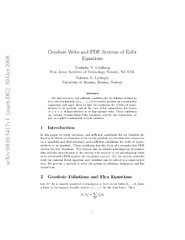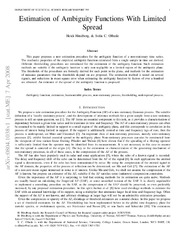Artikler, rapporter og annet (matematikk og statistikk): Nye registreringer
Viser treff 341-357 av 357
-
Geodesic Webs and PDE Systems of Euler Equations
(Journal article; Tidsskriftartikkel; Peer reviewed, 2008-10-30)We find necessary and sufficient conditions for the foliation defined by level sets of a function f(x1, ..., xn) to be totally geodesic in a torsion-free connection and apply them to find the conditions for d-webs of hypersurfaces to be geodesic, and in the case of flat connections, for d-webs (d ≥ n + 1) of hypersurfaces to be hyperplanar webs. These conditions are systems of generalized Euler ... -
Estimation of Ambiguity Functions With Limited Spread
(Research report; Forskningsrapport, 2008-04-07)This paper proposes a new estimation procedure for the ambiguity function of a non-stationary time series. The stochastic properties of the empirical ambiguity function calculated from a single sample in time are derived. Different thresholding procedures are introduced for the estimation of the ambiguity function. Such estimation methods are suitable if the ambiguity function is only non-negligible ... -
On Rank Problems for Planar Webs and Projective Structures
(Chapter; Bokkapittel, 2008-12-03)We present some old and recent results on rank problems and linearizability of geodesic planar webs -
A piece-wise affine contracting map with positive entropy
(Working paper; Arbeidsnotat, 2005-04-10)We construct the simplest chaotic system with a two-point attractor. -
Modeling temporal fluctuations in avalanching system
(Working paper; Arbeidsnotat, 2008-07-22)We demonstrate how to model the toppling activity in avalanching systems by stochastic differential equations (SDEs). The theory is developed as a generalization of the classical mean field approach to sandpile dynamics by formulating it as a generalization of Itoh’s SDE. This equation contains a fractional Gaussian noise term representing the branching of an avalanche into small active clusters, ... -
A stochastic theory for temporal fluctuations in self-organized critical systems
(Working paper; Arbeidsnotat, 2008-07-22)A stochastic theory for the toppling activity in sandpile models is developed, based on a simple mean-field assumption about the toppling process. The theory describes the process as an anti-persistent Gaussian walk, where the diffusion coefficient is proportional to the activity. It is formulated as a generalization of the Itˆo stochastic differential equation with an anti-persistent fractional ... -
Geodesic Webs of Hypersurfaces
(Working paper; Arbeidsnotat, 2008-12-11)In the present paper we study geometric structures associated with webs of hypersurfaces. We prove that with any geodesic (n + 2)-web on an n-dimensional manifold there is naturally associated a unique projective structure and, provide that one of web foliations is pointed, there is also associated a unique affine structure. The projective structure can be chosen by the claim that the leaves of all ... -
On a class of linearizable planar geodesic webs
(Working paper; Arbeidsnotat, 2008-12-13)We present a complete description of a class of linearizable planar geodesic webs which contain a parallelizable 3-subweb. -
Feedback Differential Invariants
(Journal article; Tidsskriftartikkel, 2008-12-07)The problem of feedback equivalence for control systems is considered. An algebra of differential invariants and criteria for the feedback equivalence for regular control systems are found. -
Feedback Equivalence of 1-dimensional Control Systems of the 1-st Order
(Working paper; Arbeidsnotat, 2008-12-09)The problem of local feedback equivalence for 1-dimensional control systems of the 1-st order is considered. The algebra of differential invariants and criteria for the feedback equivalence for regular control systems are found. -
Dynamics and entropy in the Zhang model of Self-Organized Criticality
(Working paper; Arbeidsnotat, 2005-09-12)We give a detailed study of dynamical properties of the Zhang model, including evaluation of topological entropy and estimates for the Lyapunov exponents and the dimension of the attractor. In the thermodynamic limit the entropy goes to zero and the Lyapunov spectrum collapses.1 -
Entropy via multiplicity
(Working paper; Arbeidsnotat, 2005-09-30)The topological entropy of piecewise affine maps is studied. It is shown that singularities may contribute to the entropy only if there is angular expansion and we bound the entropy via the expansion rates of the map. As a corollary we deduce that non-expanding conformal piecewise affine maps have zero topological entropy. We estimate the entropy of piecewise affine skew-products. Examples of ... -
The Capabilities of the EISCAT Svalbard Radar for Inter-hemispheric Coordinated Studies
(Journal article; Tidsskriftartikkel; Peer reviewed, 2002)In this article we want to present the EISCAT Svalbard Radar (ESR) in some detail, as well as some of the instruments of interest for ionospheric and magnetospheric research that are located in the vicinity of it. We particularly describe how this instrument cluster, close to the geomagnetic conjugate point of the Chinese Antarctic Zhongshan station, can contribute to inter-hemispheric coordinated ... -
A quadratic reciprocity law for elliptic curves
(Journal article; Tidsskriftartikkel; Peer reviewed, 2008)If E is an elliptic curve, then the Galois group of the extension generated by the n-torsion points acts on these points. We prove a quadratic reciprocity law involving this group action. This law is an extension of the usual quadratic reciprocity law. -
Factorisation patterns of division polynomials
(Journal article; Tidsskriftartikkel; Peer reviewed, 2004-05)The choice of an elliptic curve for the implementa- tion of an elliptic curve cryptosystem requires count- ing the number of points on such a curve over a fi- nite field. An improvement of Schoof’s algorithm for counting the number of rational points on an ellip- tic curve defined over a finite field takes advantage of some factor of the division polynomials. In this paper, we study the ... -
A simple criterion for the m-cyclicity of the group of rational points on an elliptic curve defined over a finite field
(Journal article; Tidsskriftartikkel; Peer reviewed, 2006-02)We give a simple criterion for the cyclicity of the m-torsion subgroup of the group of rational points on an elliptic curve defined over a finite field of characteristic larger than 3 for m = 2, 3, 4, 6, 12. -
Nature reserves as a bioeconomic management tool. A simplified modeling approach
(Working paper; Arbeidsnotat, 2006-02)This paper demonstrates analytically how a nature reserve may protect the total population, realize maximum sustainable yield (MSY), maximum economic yield (MEY) and consumer surplus (CS) and how this depends on biological growth, migration, reserve size and economic parameters. The pre-reserve population is assumed to follow the logistic growth law and two post-reserve growth models are discussed. ...


 English
English norsk
norsk















